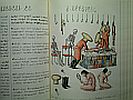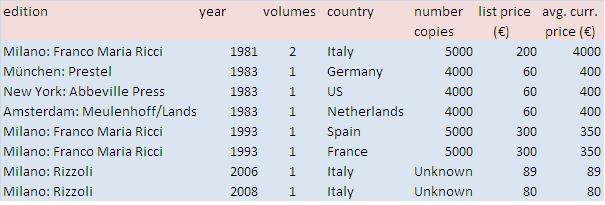Does weird content perpetuate rare book status? For some ideas on this topic one must closely examine the most famous weird book ever printed – Codex Seraphinianus. It is the creation of the Italian architect, artist, and designer Luigi Serafini, who can perhaps be best described as more of a visionary than a designer. Besides books, he put his name on among other things ceramics, furniture, ballet productions, marketing logos and paintings. He is also the visionary author/artist of Pulcinellopedia (piccola) and Le Storie Naturali.
What is most striking about Codex Seraphinanus, is that it is filled with unseemly and unexplainable illustrations which do not point to a logical or conventional solution. In addition, the book is written in a language which can only be described as Luigi Seraphini’s own unique and wholly self thought of dialect, which nobody has since succeeded in deciphering.
5000 copies of Codex Seraphinianus were first published in 1981 in two volumes by Milano: Franco Maria Ricci. Then in 1983, a single volume version was released in the USA, Germany, and the Netherlands. This was followed by an “augmented edition” in 1993 that was released in Spain and France. Then, starting in 2006, larger editions were released by Rizzoli.
These are not small limited editions. Even the 1981 first edition of 5,000 copies is substantial quantity. How does a relatively modern book release with ample availability become a rare book? The answer lies on the other side of the equation – demand. Serafini and Codex Seraphinianus in particular have gained popularity and publicity thanks to the World Wide Web. Human curiosity and intrigue fueled the demand to browse, examine, analyze, and decipher Serafini’s Codex, and the publishers, in turn, delivered.
When Serafini himself was asked to explain his mysterious work published in Codex Seraphianus, his response was honest and witty: “I’d call it a written dream. An image of something that has been deformed, and yet is very recognizable. The writing itself is vaguely reminiscent of Arabic script, although it is entirely the fruit of my imagination. And the strange thing is that it sort of looks realistic, intelligible. In fact a few people have actually studied it in some detail and have discovered that there are certain shapes, certain signs that are recurrent and that give the impression of real words and a kind of syntax.” It is not an exaggeration that people all over the world have tried and are still trying to decipher the contents of the book and discover its meaning. Serafini’s puzzle book managed to attract a worldwide range of audience that boosted sales and prices despite his confession that it is nothing more than the work of his imagination.
Indeed, Serafini could not be any more truthful. After numerous attempts by all kinds of players from all kinds of backgrounds to show the meaning to the Codex Seraphinianus, no one is even remotely close to declaring Eureka! A little over seventy years ago, Russian-born English cartographer, Alexander D’Agapeyeff authored a book by the name of Codes and Ciphers. The first edition contains an elusive cipher that was deleted from later editions of the book when D’Agapeyeff is said to have admitted to having forgotten how he encrypted it. Quite contrary to D’Agapeyeff, Serafini’s later editions were not deleted but augmented.
Work of mystery or not, Serafini’s poetic perception of the world is the real source of the phenomenal magnetism towards Codex Seraphinianus. He managed not only to mediate between the world of dreams and reality but also to blur the gap between them: “My work in reality is derived from a completely autonomous vision. I began to realize that certain memories and recollections manifest the vision into being. Sometimes the images are receptors acting as antennae in the air waves. When this happens the visions are of things to come.”


{ 5 comments… read them below or add one }
I purchased a copy of the first American edition printed in 1983 through a catalogue that sold over-stocked books. The description in the catalogue sounded wonderful, so I purchased this for $25 for my son, a budding artist at five years of age.
You can imagine my surprise when I saw the book…..it was absolutely the most amazing book I had ever seen! My first reaction was, “Did this person do the artwork for ‘Fantastic Planet’ in 1976?”
Still own the book. It has given all of us in my family so many hours of enjoyment looking at this bizarre world, and wondering what was being said in the script.
Very interesting article… i have also asked this question myself: “Do these strange illustrations perpetuate the rarity of the book?”
I am a huge fan on Serafini and recently acquired a ceramic piece signed and limited to an edition of 100… Of all the posts online this is the only one where i can find any reference to his early ceramic works… Do you possibly know how i could get this valued or get any more information on it?
Kind regards,
Ramon
Sorry we have no art/ceramics appraisal capabilities. Best to check with some of the auction houses, appraisers specializing in that type of material.
I own a copy of this fascinating book and Mr Serafini has steatd it is purely Asemic writing in an interview, so any translation is apparently impossible. But it is still a marvel to behold and may still hold some secrets
Codex Seraph In I Anus.Codex can mean Book or Collection of Writings. A Seraph is also a Seraphim or Angel. The word Angel originally meant Messenger or Message. The word In can also mean From. The word I can also refer to My. And Anus is anhteor word for Rectum. So the title could be constructed to read “A collection of wisdom that is a message from my rectum. In the colloquial” “I’m talking out of my Ass.”
{ 2 trackbacks }